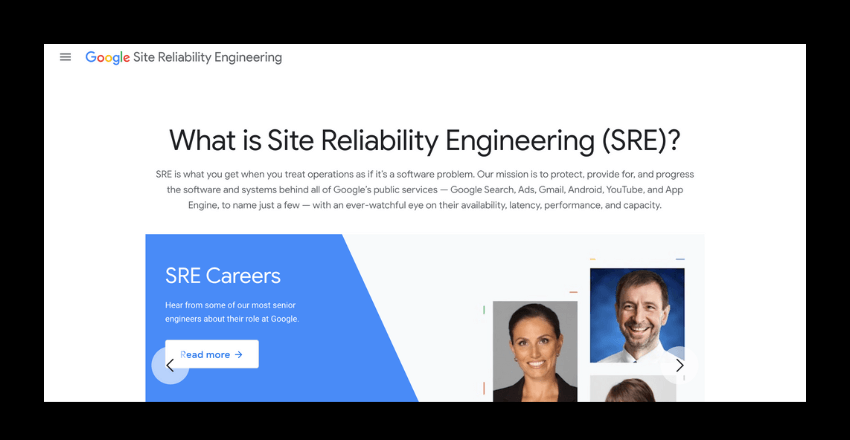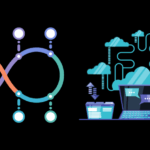
Building Reliable Systems is your roadmap to operational excellence, blending software engineering and DevOps practices for unparalleled reliability.
Ensuring system reliability is crucial for any business, particularly those operating online. System downtime can result in lost revenue, decreased customer trust, and a damaged reputation. Enter site reliability engineering (SRE), a discipline that brings stability and resilience to businesses.
SRE is more than just traditional operations or software engineering. It takes a holistic approach to ensuring system reliability, including error budgeting, monitoring, incident response, automation, and more. By implementing SRE principles and practices, businesses can build reliable and fail-safe systems that can withstand disruptions.
Key Takeaways
- Site reliability engineering (SRE) is a discipline that brings stability and resilience to businesses by ensuring system reliability.
- SRE takes a holistic approach to ensuring system reliability, including error budgeting, monitoring, incident response, automation, and more.
- Implementing SRE principles and practices can help businesses build reliable and fail-safe systems that can withstand disruptions.
Understanding Site Reliability Engineering
Site reliability engineering (SRE) ensures reliable, efficient operation of large-scale systems. It’s a mix of traditional operations and software engineering, aimed at boosting business stability and resilience.
Unlike traditional operations, which maintain system stability, SRE fixes issues proactively. Unlike traditional software engineering, which focuses on innovation, SRE values system reliability over frequent feature releases.
SRE‘s core principles focus on system reliability and supporting development and operations teams. Implementing these principles needs deep system understanding, extensive automation, and strong team collaboration.
How SRE differs from traditional operations and software engineering
SRE differs from traditional operations mainly in its proactive approach. SRE teams aim to fix issues before they affect users. They focus not just on maintaining, but also improving system stability through automation and monitoring.
SRE also varies from traditional software engineering by prioritizing reliability over feature releases. While traditional teams may push for frequent updates, SRE teams may slow down to focus on system reliability.
Many big companies have adopted SRE principles. Google, for example, was an SRE pioneer. Their team has been key in shaping the discipline’s core principles.
Key Components of Site Reliability Engineering
Site reliability engineering (SRE) encompasses a range of practices and processes to ensure system reliability and availability. Key components of SRE include error budgeting, monitoring, incident response, and automation.
Error Budgeting
Error budgeting is a core SRE concept. It helps teams find a balance between innovation and reliability. An error budget sets the acceptable failure level before user experience suffers. This lets SRE teams focus on reliability but leaves space for innovation.
For instance, Google’s SRE teams have a percentage-based error budget. This allows Google to keep innovating while maintaining system reliability.
Monitoring
Effective monitoring is crucial for proactive reliability. SRE teams need to understand system health and user interactions. Monitoring tools offer real-time issue detection, enabling quick fixes to cut downtime.
Monitoring frameworks vary but aim to give system visibility. For instance, Prometheus and Grafana are popular open-source tools. They help collect and display key system metrics.
Incident Response
Incident response processes are key to reducing system failure impact and quick recovery. SRE teams need a clear action plan. This involves an incident response team, playbooks, and post-incident reviews for improvement.
A strong playbook should have a clear escalation path, set communication channels, and a process for incident resolution. Effective response can prevent a minor outage from becoming a major system failure.
Automation
Automation is crucial in SRE, helping teams scale and streamline operations. It frees teams for strategic tasks that boost system reliability and performance. Automation varies from infrastructure provisioning to testing and deployment.
Tools like Ansible, Puppet, and Chef offer strong automation capabilities. Many also use CI/CD pipelines for continuous delivery. Effective automation cuts human error and enhances efficiency and reliability.
Error Budgeting: Balancing Innovation and Reliability

Error budgeting is a core principle in site reliability engineering (SRE). It helps balance innovation and system reliability. The framework defines acceptable service disruption and sets risk levels for innovation.
The aim is to balance new features and reliability. Calculate allowable errors over a set period, like a quarter. Translate this into a percentage or time limit. Errors should be quantifiable, like system downtime or API errors.
For effective error budgeting, set continuous thresholds and monitoring. This gives real-time system health awareness. Best practice is to share the error budget with stakeholders, set targets, and track progress.
Implementing Error Budgeting: Best Practices
When using error budgeting, follow these best practices:
- Define thresholds: Set acceptable service disruption levels in time or percentages.
- Track and monitor: Use monitoring to track SLOs and ensure budgets are met.
- Share with stakeholders: Make sure everyone knows the error budgets and the risks of exceeding them.
- Drive innovation: Use error budgets to prioritize improvements.
System reliability needs a balanced approach to innovation and reliability. Error budgeting is key for focus, realistic goals, and progress measurement.
Monitoring and Alerting for Proactive Reliability
Robust monitoring and alerting systems are key in site reliability engineering (SRE). The right tools help detect issues early, preventing major downtime or system damage.
Monitoring tracks system metrics like CPU usage and network traffic. This data helps teams spot trends and make data-driven decisions for better reliability.
Alerting notifies teams of issues. Alerts are based on set thresholds or rules, like server outages. This allows quick incident response and less system impact.
Monitoring Tools and Frameworks
There are numerous monitoring tools and frameworks available to SRE teams, each with its unique features and capabilities. Some of the commonly used ones include:
| Tool/Framework | Description |
|---|---|
| Prometheus | An open-source monitoring toolkit for collecting and querying metrics. It provides advanced querying and alerting capabilities and integrates well with various cloud platforms. |
| Nagios | A powerful and widely used monitoring system that monitors hosts, services, and network devices. It provides alerts and notifications when issues occur and supports a range of plugins for additional functionality. |
| Grafana | A data visualization platform that provides real-time monitoring and alerting capabilities. It can integrate with various data sources and offers flexible dashboard creation and sharing. |
These tools and frameworks can be customized to fit the specific needs of an organization and its systems.
Setting Up Effective Monitoring and Alerting Systems
To set up effective monitoring and alerting systems, teams should follow some best practices, such as:
- Define clear metrics and performance indicators that align with business goals and system requirements.
- Set up alerts based on meaningful thresholds and rules that capture potential issues before they become critical.
- Configure alert notifications to be sent to the right people at the right time, ensuring timely and efficient incident response.
- Regularly review and refine monitoring and alerting systems to ensure they remain relevant and effective.
By implementing these practices, SRE teams can build proactive monitoring and alerting systems that help ensure system reliability.
Incident Response: Minimizing Downtime and Impact

Incidents are unavoidable in system reliability. How a business responds is key to reducing downtime and outage effects. Incident response processes need to be clear and quick.
A skilled incident response team is crucial. They should be trained to identify and resolve incidents fast and efficiently. Clear protocols and escalation paths ensure timely involvement of the right people.
Incident response playbooks are vital. They offer a structured way to handle scenarios and minimize impact. These playbooks should be regularly reviewed and updated.
Post-incident reviews are key for continuous improvement. They help learn from incidents and spot improvement areas. Insights from these reviews can update playbooks and boost system reliability.
Automation: Scaling and Streamlining Operations
Automation is a core principle in site reliability engineering (SRE). It scales and streamlines operations, freeing teams for tasks needing human skills. Automating routine tasks like deployments cuts human error, boosts efficiency, and keeps systems reliable.
Various DevOps tools like containerization and configuration management help. They manage infrastructure as code, easing app deployment and scaling.
Automation is also key for system reliability. Automated monitoring and alerting help catch issues early. Automated incident response minimizes downtime and impact.
However, it’s crucial to ensure automation isn’t an error source. Teams should constantly monitor and test their automated processes. Any changes to infrastructure or processes should be carefully planned and tested before production deployment.
Building Resilience Through Chaos Engineering
Chaos engineering may seem odd but it’s key for system resilience. It involves deliberately causing failures to find weaknesses and boost reliability.
The approach uses controlled experiments to simulate failures like system overload, network outages, or disk failures. The goal is a safe space for engineers to spot and fix issues before they hit live production.
This method is great for uncovering hidden dependencies, race conditions, and other tricky failure scenarios.
A major benefit is proactive problem-solving. Regular experiments help teams understand system stress behavior and plan incident mitigation.
Though it may seem tough, plenty of resources exist to help. Open-source tools like Chaos Monkey, Gremlin, and Chaos Toolkit aid in controlled testing.
Chaos engineering is a strong tool for resilience in high-stress systems. By doing regular chaos experiments, SRE teams make their systems more reliable and fail-safe.
Continuous Improvement: Lessons Learned and Iterations
Continuous improvement is vital in site reliability engineering (SRE). It helps teams learn from incidents and make iterative improvements. A feedback loop process is key for ongoing learning and betterment. This involves:
- Spotting improvement areas from incidents and stakeholder feedback.
- Creating and executing a plan for these improvements.
- Measuring effectiveness of the changes.
- Making adjustments to ensure results.
Using a feedback loop, SRE teams boost system reliability and lessen incident impact.
Learning from incidents is another crucial part. Post-incident reviews help understand root causes and find improvement areas. These reviews should include all stakeholders for a complete understanding. The findings feed into the feedback loop for ongoing betterment.
Lastly, fostering a culture of continuous improvement is essential. Team retrospectives are good for gathering feedback and spotting improvement areas. These insights help SRE teams refine plans within the feedback loop process.
Challenges and Best Practices in Site Reliability Engineering

SRE implementation has its challenges, but they can be tackled with careful planning and execution.
A major hurdle is cultural resistance to change. SRE needs a shift from reactive to proactive thinking. Collaboration and continuous improvement are essential.
Another issue is the balance between innovation and reliability. Error budgeting helps set downtime or error limits, allowing controlled innovation.
Proper tools and processes are crucial for system reliability. Monitoring and alerting systems must be strong. Incident response should be quick and effective. Automation minimizes human error.
Considerations for Implementing SRE
SRE implementation depends on system architecture and environment. For companies with complex or legacy systems, it demands a lot of effort and resources.
Evaluating the organization’s systems and processes is crucial. SRE needs a phased approach, starting small and then scaling up.
Ongoing monitoring and evaluation of SRE practices are key. This involves post-incident reviews and process iteration for better reliability.
In summary, SRE adoption needs a cultural shift, a balance between innovation and reliability, the right tools and processes, and attention to architecture and environment. Overcoming these challenges leads to system stability and resilience.
Conclusion: Empowering Business with Stability and Resilience
SRE is key for system reliability and business stability. Using SRE methods, companies can create fail-safe systems that reduce downtime and boost customer satisfaction. This also speeds up innovation.
Essential SRE elements like error budgeting, monitoring, incident response, automation, chaos engineering, and continuous improvement help achieve these goals. They let SRE teams find a balance between innovation and reliability, manage risks, optimize operations, and make iterative improvements.
Challenges like resistance to change or system architecture issues can arise in SRE adoption. However, these can be tackled with best practices and careful planning. Successful case studies offer insights into effective SRE use.
In summary, adopting SRE is vital for business stability and resilience. It enhances reliability, customer satisfaction, and innovation, while cutting down downtime and disruption.
FAQs

1. What is Site Reliability Engineering (SRE) in the context of Building Reliable Systems?
Answer: Site Reliability Engineering (SRE) is a discipline that incorporates aspects of software engineering to create a balance between reliability, availability, and performance in large-scale systems. In the context of building reliable systems, SRE provides a set of principles and practices to ensure system resilience and efficiency.
Pro Tip: Adopt the SRE mantra: “Hope is not a strategy.” Always plan for failure and know how to recover.
2. How does Error Budgeting work in SRE?
Answer: Error budgeting is a key SRE concept that quantifies the acceptable level of errors or downtime a system can have. It helps teams balance between innovation and reliability. For example, if you have a 99.9% uptime target, your error budget is 0.1%.
# Example: Calculating Error Budget uptime_target = 99.9 error_budget =
100 - uptime_targetPro Tip: Use error budgets to prioritize work. If you’re exceeding the budget, focus on reliability over new features.
3. What are SRE’s core principles for building reliable systems?
Answer: SRE’s core principles include automation, proactive problem-solving, and balancing innovation with reliability. These principles guide the design, deployment, and operation of large-scale systems.
Pro Tip: Implement automation wherever possible, from CI/CD pipelines to auto-scaling and self-healing systems.
4. How do Monitoring and Alerting contribute to reliability?
Answer: Monitoring provides real-time insights into system health, while alerting notifies teams of issues that need immediate attention. Together, they enable quick identification and resolution of problems.
# Example: Prometheus Alert Rule groups: - name: example rules:
- alert: HighErrorRate expr: job:request_errors_total /
job:requests_total > 0.05Pro Tip: Customize alert thresholds to avoid alert fatigue. Not every issue requires immediate attention.
5. What role does Automation play in SRE?
Answer: Automation is crucial for scaling and streamlining operations. It minimizes human error and frees up teams to focus on more complex tasks.
# Example: Ansible Playbook for Automated Deployment --- - hosts:
webservers tasks: - name: ensure apache is at the latest version yum:
name: httpd state: latestPro Tip: Always test your automation scripts in a controlled environment before deploying them in production.
6. How important is Incident Response in SRE?
Answer: Incident response is vital for minimizing the impact of system failures. A well-defined incident response playbook should include escalation paths, communication channels, and resolution processes.
Pro Tip: Conduct regular incident response drills to ensure your team is prepared for real-world scenarios.
7. Can you provide some examples of companies successfully implementing SRE?
Answer: Companies like Google, Netflix, and LinkedIn have successfully implemented SRE to maintain high levels of system reliability while fostering innovation.
Pro Tip: Study case studies from these companies to understand how they’ve adapted SRE principles to their unique challenges.
Q: What are reliable systems?
A: Reliable systems are ones that are fundamentally secure and dependable, keeping data and services available and functioning even in the face of failures.
Q: Why is building secure and reliable systems important?
A: Building secure and reliable systems is important because it ensures that sensitive data is protected, services remain available, and users can trust the system to perform as expected.
Q: What does “reliability matters” mean?
A: “Reliability matters” means that the ability of a system to consistently perform its intended function without failure is of great importance.
Q: How can I design scalable and reliable systems?
A: To design scalable and reliable systems, it is crucial to consider factors such as distributed architectures, fault tolerance, and load balancing.
Q: What are some best practices for building secure and reliable systems?
A: Some best practices for building secure and reliable systems include centralizing security and SRE efforts, implementing secure coding practices, and regularly testing and monitoring the system for vulnerabilities.
Q: Why is security crucial to the design of reliable systems?
A: Security is crucial to the design of reliable systems because vulnerabilities and breaches can lead to system failures, data loss, and compromised user trust.
Q: What role does a developer play in building secure and reliable systems?
A: Developers play a critical role in building secure and reliable systems as they are responsible for implementing secure coding practices, addressing potential vulnerabilities, and following security guidelines.
Q: Can you recommend any resources or websites related to building reliable systems?
A: The Google SRE website and the book “Building Secure and Reliable Systems” are excellent resources for learning more about building reliable systems.
James is an esteemed technical author specializing in Operations, DevOps, and computer security. With a master’s degree in Computer Science from CalTech, he possesses a solid educational foundation that fuels his extensive knowledge and expertise. Residing in Austin, Texas, James thrives in the vibrant tech community, utilizing his cozy home office to craft informative and insightful content. His passion for travel takes him to Mexico, a favorite destination where he finds inspiration amidst captivating beauty and rich culture. Accompanying James on his adventures is his faithful companion, Guber, who brings joy and a welcome break from the writing process on long walks.
With a keen eye for detail and a commitment to staying at the forefront of industry trends, James continually expands his knowledge in Operations, DevOps, and security. Through his comprehensive technical publications, he empowers professionals with practical guidance and strategies, equipping them to navigate the complex world of software development and security. James’s academic background, passion for travel, and loyal companionship make him a trusted authority, inspiring confidence in the ever-evolving realm of technology.







